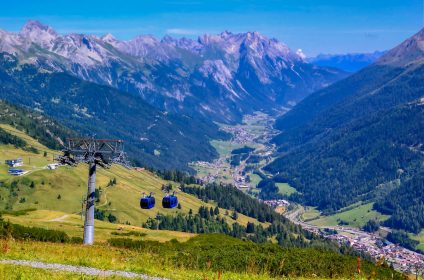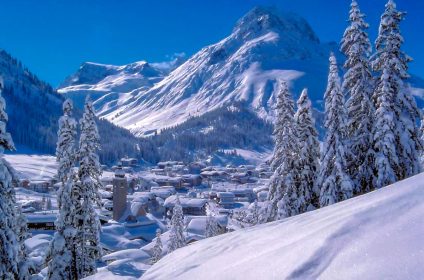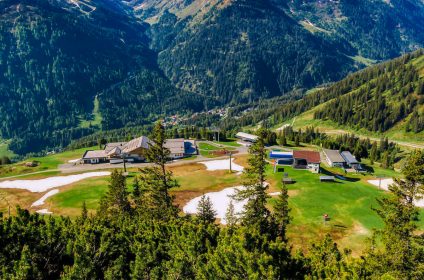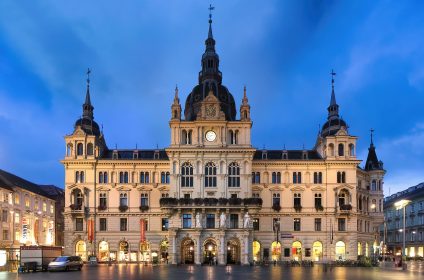Sankt Anton am Arlberg
Legendary ski resort Sankt Anton am Arlberg, sometimes known as St. Anton, is tucked away in the Austrian Alps. Deeply ingrained in history, it is revered as the origin of the Arlberg technique, a trailblazing downhill skiing method developed by the local star Hannes Schneider. This bold approach transformed the sport, and St. Anton’s legendary ski background is further shown by its hosting of the Alpine World Ski Championships in 2001 and its central part in producing many Olympic and World Cup winners. Though well-known for its winter appeal, St. Anton also enthralls summer visitors, attracting bikers, hikers, and climbers equally.
Beautifully located on the banks of the Rosanna River, St. Anton is in central Tyrol and acts as a major cross-roads for travel between Austria and Switzerland. With a population of almost 2,400 and a 165.81 km2 area, the village radiates a wonderful atmosphere. Its pedestrian area is alive with activity, presenting a varied range of stores, eateries, bars, and hotels to suit the many preferences of its guests. With 94 cable cars and ski lifts as well as carefully maintained paths spanning 340 km and deep-snow runs covering 200km, the ski area boasts a rich infrastructure. Towering at 2,811 meters above sea level, Valluga Peak provides thrilling descents and breathtaking views for the daring.
Because of its varied terrain and consistent snow conditions, St. Anton’s appeal spans skiers of all proficiencies, from beginners to experienced experts. While experienced enthusiasts can push their boundaries on steeper slopes and off-piste adventures, beginners can find their footing on mild hills. Still, the thrill doesn’t fade with the lowering light. Legendary St. Anton’s après-ski scene features energetic slope-side bars and nightclubs drawing throngs of revelers. Among the most popular venues are the Piccadilly, the Mooserwirt, and the Krazy Kanguruh, where skiers may mix with other aficionados and mark their successes.
St. Anton opens more winter adventures right as part of the large Arlberg ski area. With a single lift pass, skiers can access nearby resorts including Lech, Zürs, Stuben, and St. Christoph, so revealing a large network of slopes and trails.
Originally one of the first Alpine locations to greet guests, St. Anton’s legacy of tourism and skiing spans the 19th century. For British visitors, the mesmerizing mountain views and growing winter sports appeal especially. Established in 1901, the Ski Club Arlberg is evidence of this legacy; with almost 9,000 members and the distinction of being among the biggest and oldest ski clubs worldwide.
Over the years, St. Anton has drawn ski pioneers, teachers, filmmakers, and celebrities who have all helped to contribute to its ongoing reputation and glory. The architecture, customs, and oral stories handed down over years clearly show the historical relevance of the village.
The lifeblood of St. Anton’s economy, tourism creates jobs and generates income. With almost 1.5 million overnight stays a year, the village welcomes a varied range of guests. St. Anton appeals to those from other European nations, North America, Australia, and Asia in addition to mostly drawing visitors from Germany, the United Kingdom, the Netherlands, and Scandinavia. Serving to the various interests and tastes of visitors from all around the world, this international appeal confirms St. Anton’s reputation as a worldwide travel center.
Tucked in western Tyrol, St. Anton boasts a picturesque setting close to Switzerland’s and Liechtenstein’s borders. Perched 1,304 meters above sea level, the community is part of the Inn’s tributary, the Rosanna River’s valley. Comprising part of the Lechtal and Verwall Alps, the Arlberg massif commands the surroundings. Rising to an amazing 3,036 meters, the Parseierspitze is the loftiest peak in the area and adds to the stunning view. Often covered in snow during the winter, the Arlberg pass—which links Tyrol and Vorarlberg—gives the scene its elegant appeal.
St. Anton has a continental climate, marked by cool, snowy winters against sunny summers. With a mean annual temperature of 6.4°C, one guarantees a consistently pleasant range all year long; January’s low is -3.7°C and July’s peak is 16.4°C. With an average annual precipitation of 1,066 millimetres, mostly in the form of snow from November to April, the area While the slopes show an amazing 4 meters, the village itself suffers snow depths of up to 2 meters, which makes perfect conditions for winter sports. Usually running from early December to late April, the ski season gives plenty of time for guests to engage in their chosen activities. On the other hand, the summer months bring longer daylight hours and pleasant temperatures ideal for outdoor activities including climbing, biking, and hiking.
About 2,500 people live in St. Anton and create a close-knit community. Although most of the people living in the village are Austrian, a clear presence of foreigners adds to its cultural variety. Though many residents are fluent in English and other languages to meet the needs of foreign guests, German is the official language. Roman Catholicism is the most followed religion; ninety percent of the population identifies as Catholic. Still, the community welcomes religious variety; people from Protestant, Orthodox, Muslim, nonreligious backgrounds add to its rich tapestry.
The infrastructure of St. Anton serves both locals and guests equally. The community claims a school, a kindergarten, a library, a post office, a police station, a fire brigade, a medical centre, and a church. These facilities guarantee that residents have access to basic services and give visitors comfort and peace of mind as well.
St. Anton’s economy depends mostly on tourism—especially winter travel. From cheap hostels and apartments to opulent hotels and chalets, the village presents a wide spectrum of housing choices. Though rates vary depending on the season, location, and amenities, the average nightly is 150 euros. At many different dining venues—including restaurants, cafes, bakeries, and supermarkets—visitors can enjoy regional food and specialties.
Apart from lodging and food, St. Anton boasts a range of stores fulfilling the needs and wishes of visitors. While sports stores provide gear, clothes, and accessories for different activities, souvenir stores feature mementos of the trip. Many ski rental businesses and ski schools are easily accessible for those who want to ski; they provide lessons and professional advice suitable for all levels. Although tourism is the main economic engine, St. Anton gains from trade, industry, and agriculture as well as from forestry.
Given several means of transportation, St. Anton’s accessibility is a big benefit for guests. Those driving by car can exit at St. Anton from either the A12 motorway from Innsbruck or the A14 motorway from Bregenz. For a price the village provides lots and garages among other parking options. On the other hand, the Arlberg railway offers train lines linking St. Anton with Innsbruck, Zurich, Munich, Vienna, and other big cities. From most hotels and ski lifts, the train station—which is in the middle of the village—is conveniently reachable on foot. For those who would want bus travel, regular and seasonal bus services from Innsbruck, Zurich, Munich, and Salzburg also offer further choices.
Currency
Country
Area code
Population
Area
Official language
Elevation
Time zone
Sankt Anton am Arlberg Travel Guide
Sankt Anton am Arlberg Info Card
| Category | Information |
|---|---|
| Location | St. Anton am Arlberg is a village and ski resort in the Austrian state of Tyrol, on the Rosanna River |
| Elevation | The village lies at 1,304 m (4,278 ft) above sea level |
| Population | The population was 2,372 as of 2018 |
| Tourism office | The tourism office is located at Dorfstraße 8, 6580 St. Anton am Arlberg |
| Postal code | The postal code is 6580 |
| Phone prefix | The phone prefix is 05446 |
| Area | The total area is 165.81 km 2 (64.02 sq mi) |
| Established | The village was first mentioned in 1218 as “Sanctus Antonius” |
| Language | The official language is German, but many locals also speak English and other languages |
| License plate | The license plate is LA (for Landeck district) |
| Districts & Neighborhoods | The village consists of several districts and neighborhoods, such as Nasserein, St. Jakob, St. Christoph, and Moos |
| Weather & Climate | The weather and climate are typical of the Alps, with cold and snowy winters and mild and sunny summers |
| Best Time To Visit | The best time to visit depends on the activities you prefer, but generally the winter season (December to April) is ideal for skiing and snowboarding, while the summer season (June to September) is great for hiking and biking |
| Attractions & Landmarks | Some of the attractions and landmarks in and around St. Anton am Arlberg are: the Ski Museum, the Arlberg Pass, the Galzigbahn Funitel, the Tanzcafé Arlberg Music Festival, the White Thrill ski race, and the St. Anton Summer Card |



















